
|
![]()
Greatest Films of the 1940s
1940 | 1941 | 1942 | 1943 | 1944 | 1945 | 1946 | 1947 | 1948 | 1949
Title Screen Film Genre(s), Title, Year, (Country), Length, Director, Description 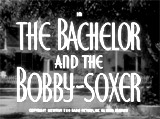

The Bachelor and the Bobby-Soxer (1947), 95 minutes, D: Irving Reis
Director Irving Weis' romantic 'screwball' comedy and farce was noted for its Oscar win for Best Original Screenplay (Sidney Sheldon). In the 'battle of the sexes' story, three main characters became entangled: a charming bachelor-playboy artist, an impressionable teenaged girl, and a female judge. As the film opened in a municipal courtroom, Richard "Dickie" Nugent (Cary Grant) - a womanizing, handsome, and well-dressed bachelor-playboy - had been arrested after a brawl in The Vampire Club - an LA nightclub (instigated by two women fighting over his attentions). Although it was his third such charge, he was released by presiding, serious-minded, single Judge Margaret Turner (Myrna Loy), who disregarded the contrary advice of her Asst. DA Tommy Chamberlain (Rudy Vallee), her part-time prissy and stuffy yet hopeful boyfriend. Afterwards, Nugent appeared as a guest art lecturer to Sunset HS students in a school assembly, where 17 year-old teenager Susan Turner (a grown-up Shirley Temple in a more adult role), who happened to be the ward and younger sister of Judge Turner, was in the audience with her HS boyfriend Jerry White (Johnny Sands). After the assembly, Susan interviewed Nugent for her HS newspaper and immediately became love-smitten and infatuated with him - she imagined him as her 'knight in shining armor.' Susan also brazenly decided to sneak out of her house and visit Nugent in his apartment to model a dress for him; Nugent was confronted there and accused of being a trouble-making seductor by both the Judge and ADA Tommy Chamberlain; Nugent retaliated and slugged Chamberlain in the nose. Another similar court case ensued, when Nugent was charged with assault and again called before Judge Turner; after speaking with the court psychiatrist Matt Beemish (Ray Collins), Susan's and the Judge's uncle, Nugent was encouraged to accept an unusual compromised sentence - he was ordered to date Susan. The Judge's objective was to 'cure' or end Susan's obsessive romantic interest. At a basketball game, a malt shop, and then a high school picnic, Nugent was awkwardly paired with Susan. In the latter, Nugent competed in an obstacle course race - and with the assistance of Susan bribing his competitors to lose, Nugent won the race. Meanwhile, Judge Turner was beginning to fall in love with Nugent; she invited him to dinner and dancing at the Tick Tock Club, where the elegantly-dressed couple were constantly interrupted. The evening soon spun out of control into another uncomfortable situation (when Susan began acting as a wronged female and threatened to break up with Nugent). Exasperated, Judge Turner reprimanded Nugent and then stormed off. Susan was soon convinced to return to her appropriately-aged boyfriend Jerry. In the final scene at the airport, the reluctant Judge Turner and Nugent were set up by her cupid-playing Uncle Matt Beemish to board the same TWA airplane - and spend vacation time together. To cement their relationship, she initiated the familiar bobby-soxer word-play game beginning with: "You remind me of a man."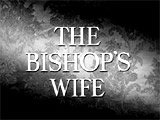



The Bishop's Wife (1947), 108 minutes, D: Henry Koster
RKO's perennial Christmas holiday fantasy classic was a sentimental and heart-warming favorite. Its screenplay by Robert Sherwood and Leonardo Bercovici was based on author-novelist Robert Nathan's 1928 novella. It was a Best Picture Oscar nominee and was beautifully photographed by Gregg Toland. The romantic comedy was poorly remade as The Preacher's Wife (1996) by director Penny Marshall, with Denzel Washington and Whitney Houston. The film opened by introducing a handsome, charming, and suave guardian angel sent from heaven named Dudley (Cary Grant). He became involved in the lives of a married couple: harried Episcopalian Bishop Henry Brougham (David Niven) and his lovely but often sad wife Julia Brougham (Loretta Young). Henry had become obsessed with building and funding a new cathedral, and was having difficulty raising money and receiving support from the wealthy and elderly Mrs. Hamilton (Gladys Cooper), the chair of the cathedral committee. Due to his preoccupations with the cathedral, the Bishop was clearly producing strains in his marriage. The very helpful and debonair Dudley was not there to assist with the cathedral's fund-raising, but to show Henry what he had been neglecting in life -- the poor and needy, the boys' choir, his parishioners and most noticeably his wife who had the incredible gift, according to Dudley of "making heaven here on Earth." When the Bishop prayed for "guidance" and divine help, Dudley showed up in his study. As time passed, Henry became increasingly annoyed with Dudley's intrusiveness, attention to Julia, and he was jealous of Julia's growing infatuation and attraction for him. All the while, Dudley kept trying to remind the Bishop about all his greater priorities in his life. On Christmas Eve, Dudley volunteered to rewrite Henry's Christmas sermon, and dictated while the typewriter took down his words. When Henry finally publically announced the importance of Julia in his life to Dudley ("Julia means more to me than my life, I'm not going to lose her"), the angel promptly announced his departure. Dudley was relieved to realize that Henry had finally straightened out his priorities - and his prayer for "guidance" (rather than for a cathedral!) had been answered. As he was summoned back to heaven after his mission was accomplished, the angel told Henry that he and everyone else would have no memory of his visit or existence: ("When I'm gone, you will never know that an angel visited your house"). At St. Timothy's Church, the Bishop delivered Dudley's sermon on Christmas Eve at midnight, while Julia beamed at him from the pews. From the street outside under a light falling snow, Dudley listened to the poignant and touching words, satisfied that his work was complete as he turned and slowly walked away - bringing the film to a heartfelt close.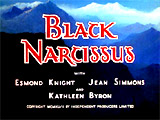



Black Narcissus (1947, UK), 100 minutes, D: Michael Powell, Emeric Pressburger
The provocative, engrossing and richly-Technicolored spiritual and erotic melodrama (with Oscar-winning cinematography by Jack Cardiff) from the UK was based on the 1939 novel by Rumer Godden. It acquired two wins for its two Oscar nominations: Best Color Cinematography (Jack Cardiff), and Best Color Art Direction-Set Decoration. The psychological drama's theme was the inevitable struggle between the spirit (or sacred realm) and the profane (or flesh). The dazzling, visual cinematographic masterpiece told about a convent (with a village school and hospital infirmary-dispensary) run by a group of five British Anglican nuns (from the Order of St. Mary) in the far remote Himalayans. There was breath-taking imagery of an exotic sultan's palace (once a bordello for concubines known as the House of Women, decorated with erotic wall paintings), with a bell tower on the edge of a 9,000 ft. precipice. The facility was donated to the convent by the local ruler General Todo Rai of Mopu (the "Old General") (Esmond Knight). The nuns were led by devout, serene and pious Sister Superior Clodagh (Deborah Kerr) who was privately being haunted and tormented by memories of a broken romance in Ireland with a past lover Con (Shaun Noble) who deserted her. Amidst the eerie atmosphere were violent and continuous winds, a half-mad elderly female caretaker Angu Ayah (May Hallatt), a 6 year-old servant boy named Joseph Anthony (Eddie Whaley Jr.) who served as a translator, mysterious drum-beats, a meditating Hindu holy man, and strange native rituals. The nuns were also aided with help and advice by a government intermediary - the sexy yet cynical and very macho British agent Mr. Dean (David Farrar), the Old General's or Prince's agent. In a sideplot, the 'Young General' or young Prince (Sabu), vain heir to the throne of the princely state, arrived at the convent to be educated. After the presence of a young village girl was also suggested by the Prince - a sexually-intriguing, lower-caste, 17 year-old native dancing girl Kanchi (Jean Simmons) arrived, and the young Prince became infatuated with her. A few major issues arose after the accidental death of a child given castor oil (that frightened the villagers away from the school or dispensary), and the young Prince's 'elopement' with Kanchi. The most disruptive problem was brought about by the unstable, troubled, sexually-conflicted, high-strung Anglican nun - the mentally insane Sister Ruth (Kathleen Byron). She was driven mad by jealousy (toward the authoritative Sister Clodagh), and her repressed and starved sexuality consumed her due to her lust for Mr. Dean. In the unnerving, climactic conclusion one evening, Sister Ruth renounced her nunhood vows of celibacy and decided not to renew her vows. She adorned herself in a bright-red forbidden dress, and applied matching red lipstick (symbolizing her break with the nunnery). She trekked down the mountain to Mr. Dean's house where she attempted to seduce him. When he curtly spurned and rejected her, she returned to the convent and sought to attack her rival Sister Clodagh, who was at the edge of the cliff at the bell-tower ringing the prayer bell. The cathartic scene ended when intended victim Sister Clodagh was saved from death as she grabbed hold of the bell-tower rope after being pushed toward the precipice by the jealous and vengeful Sister Ruth, who lost her balance and fell to her death. In the film's denouement, the nuns packed up to leave after they had failed in their spiritual mission.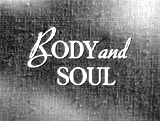



Body and Soul (1947), 104 minutes, D: Robert Rossen
Director Robert Rossen's film was one of the best, most compelling, starkly-realistic boxing sports (and film-noirish) dramas ever produced before a rash of imitators and parodies. It featured a powerful screenplay by Abraham Polonsky, with impressive fight sequences (winning an Oscar for Best Film Editing) shot with roller-skating cameramen to enhance the realism. It was uninspiringly remade as Body and Soul (1981), with a script updated to include African-American and Latino boxers, and notable female nudity. In this definitive film that also served as a cautionary morality tale (told in flashback), John Garfield (in his best film role) starred as tough, naive, dim-witted but decent Charley Davis from a poor Jewish family in the slums of the Lower East Side, who chose boxing as a means to escape his life of poverty. The pugilist successfully worked his way to the top, the middleweight championship, by both fair and unethical means (his association with crooked racketeers and fight promoters) to the disapproval of his mother Anna (Anne Revere), his free-spirited Greenwich Village artist-girlfriend Peg Born (Lilli Palmer), and his loyal lifetime friend Shorty Polaski (Joseph Pevney). He blindly believed he could become independent once he made it as the champ, but then was disillusioned when his threatening, unethical, corrupt hoodish handler Roberts (Lloyd Gough) demanded 50% of the take to help him win the championship. Charley made more wrong decisions, resulting in Shorty's accidental death, a broken engagement with his girlfriend, reckless gambling, and a harmful relationship with gold-digging nightclub vamp Alice (Hazel Brooks). He ended up indebted - and was ordered to take part in a fixed fight (he was told to fight all fifteen rounds and lose the fight by a decision) - something that would cause him to also lose his soul and self-respect. At the last minute in the sensational final sequence, he rebelled against his operators, knocked out his challenging newcomer opponent Jack Marlowe (Artie Dorrell), returned to Peg, and rejected Roberts ("Get yourself a new boy. I retire"). When Roberts threatened Charley as he left the ring, Charley mocked him with an ironically-quipped line used earlier in the film: "What are you gonna do, kill me? Everybody dies."



Boomerang! (1947), 88 minutes, D: Elia Kazan
This semi-documentary crime film was based upon the true story of the 1924 unsolved murder of an Episcopal priest in Connecticut. The elderly, beloved and kindly priest Father George Lambert (Wryley Birch) of Bridgeport, CT was murdered (by gunshot) during his regular evening walk at a street-corner by an unidentified killer. Police Chief Harold F. 'Robbie' Robinson (Lee J. Cobb) faced tremendous political pressure to quickly find the suspect. There were seven witnesses to the shooting, but the killer's face wasn't conclusively seen, and there were no other clues. The Morning Record (and its ace political reporter Dave Woods (Sam Levene)) stirred up trouble by blaming the current administration for being soft on crime. Out-of-town WWII veteran and unemployed drifter John Waldron (Arthur Kennedy) was soon targeted as the suspected murderer (he was arrested in Cleveland, Ohio), although he vehemently denied being involved. Forensics evidence showed that the bullet came from his gun. He was exhaustively questioned by the police chief and lead detective Lieutenant White (Karl Malden) for two days, and gave in by signing a confession - under duress. State's District Attorney Henry Harvey (Dana Andrews), a potential candidate for governor, was assigned to try and prove Waldron's innocence - obvious, the suspect was a victim of prejudgment.During the court hearing, Harvey destroyed the prosecution's case and exonerated Waldron. He reenacted the crime seven times - proving that none of the unreliable eyewitnesses could have seen the killer from where they were positioned on the street. He also demonstrated that the intense grilling from police was unfairly brutal and that the confession was coerced. He also submitted five expert ballistics reports that disproved the bullet came from Waldron's gun. In a dramatic Russian Roulette-styled challenge, Harvey dared Waldron's loaded gun to be fired into the back of his own head - the gun wouldn't fire (revealing that it had a broken malfunctioning pin and couldn't be fired). Waldron was freed, and although the case was reopened, the real killer was never caught. [In a scene much earlier in the film, it was surmised that Lambert's killer might have been his mentally-unstable assistant pastor.]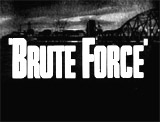


Brute Force (1947), 95 minutes, D: Jules Dassin
Director Jules Dassin's powerful, violent, claustrophobic, film-noirish crime-prison drama (with a musical score by Miklos Rozsa) told about the grim, overcrowded and dehumanizing conditions of life in the Westgate Penitentiary under the rule of the brutal chief guard - sadistic Captain Munsey (Hume Cronyn). The prison's craven Warden A.J. Barnes (Roman Bohnen) and frustrated, alcoholic Doctor Walters (Art Smith) were both weak-willed and overshadowed by the harsh and fear-inducing, fascist treatment inflicted upon the prisoners in the isolated facility. [Note: With a flashback technique, a number of the inmates described the circumstances that brought them to prison - almost all involved a duplicitous, double-crossing or scheming female.] The dictatorial chief guard was abetted in his reign of terror by stoolie inmates who spied on other prisoners and reported to him. One spy named Wilson (James O'Rear) was discovered and forced by angry convicts with flame-throwers into a huge steel punch press in the prison's workshop-factory. In Cell R 17, single-minded prisoner Joe Collins (Burt Lancaster) had been incarcerated for the theft of money to support his wheelchair-bound, cancer-stricken wife Ruth (Ann Blyth). Collins became the leader of a movement, along with gambler Spencer (John Hoyt), embezzler Tom Lister (Whit Bissell) and Robert "Soldier" Becker (Howard Duff) to begin a plan of escape. After Lister committed suicide due to a devastating mental lie told to him by Munsey about his wife Cora (Ella Raines), Collins and other convicts were punished by being put on a prison drain pipe work detail. They began to execute their complex plan. Part of the strategy was to have top mobster-prisoner Gallagher (Charles Bickford) create a diversionary 'riot' in the prison yard, while the escape would occur out of the prison's drain-pipe. To learn more about their plan just before the prison break, the suspicious Munsey beat, interrogated and tortured one inmate Louie Miller (Sam Levene), and also forced a confession from 'Freshman' Stack (Jeff Corey). During the actual prison escape out of the mine and through the outer prison gates, informant 'Freshman' who was secured to the front of a mining car, was the first to be shot and killed. A gun battle erupted in the yard, where Joe was lethally-wounded. Unheeded, he climbed to the top of the central guard tower, in flames from fire-bombs, to engage in a brutal physical fight against Munsey. After hurling him to his death below, Joe collapsed dead. Getaway truck driver Gallagher was also killed and an arriving contingent of guards tear-gassed the remainder of the convicts to capture and control them. The film concluded with Dr. Walters' bewildered, existential words about the hopelessness of the situation - delivered behind bars: "Collins and Munsey are dead. And the others. All those others. Why do they do it? They never get away with it. Alcatraz, Atlanta, Leavenworth. It's been tried in a hundred ways from as many places - and always fails, but they keep trying. Why do they do it?....Nobody escapes. Nobody ever really escapes."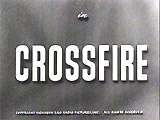




Crossfire (1947), 86 minutes, D: Edward Dmytryk
RKO's and Edward Dmytryk's noirish message drama (filmed mostly at night with low-key lighting), a taut, intelligent and exciting melodrama and murder mystery, was a rare Hollywood social issue film - a landmark film and one of the first to indict anti-Semitism, prejudice and bigotry, along with this year's Best Picture-winning Gentleman's Agreement (1947). The blunt, honest and engrossing box-office hit was based on Richard Brooks' 1945 novel The Brick Foxhole, although in the book, the victim was homosexual. It has the notable distinction of being the first B-picture to receive a Best Picture nomination. The catalyst of the film was an incident (told in various flashbacks) that occurred one drunken evening, when a group of recently-discharged soldiers on leave were partying in a Washington DC hotel nightclub with Miss Lewis (Marlo Dwyer) and her Jewish boyfriend, war hero civilian Joseph "Sammy" Samuels (Sam Levene). After some of them went to the man's apartment, there appeared to have been an argument - and later, Miss Lewis found Sammy's body. Subsequently, an investigation into the mysterious murder was conducted by a lead civilian cop, crusading district attorney Capt. Finlay (Robert Young), with help from laconic military cop Sgt. Peter Keeley (Robert Mitchum). When questioned as a suspect, ex-cop and GI veteran-soldier "Monty" Montgomery (Robert Ryan) claimed that he and another friend, civilian redneck Floyd Bowers (Steve Brodie), were with ex-WPA artist and Corp. Arthur "Mitch" Mitchell (George Cooper) in Samuels' apartment. The night's comings and goings were relayed by the suspects, in flashback, to the officers. In an abrupt move to throw off the police and silence one of the potential witnesses against him, "Monty" beat and hanged Bowers with a necktie, leaving him presumed dead. The evidence seemed to be pointing, however, towards Mitch who was suffering from post-war depression and drunkenness. Although he could not provide a convincing alibi - Keeley firmly believed in Mitch's innocence. It was soon revealed, under interrogation, that the bigoted and unhinged "Monty," who openly despised Jews, had the proper motive to murder the Jewish boyfriend with his bare hands - but his hate crime needed to be proven. After piecing together the puzzling events, Finlay set a trap for the violent, crazed and unstable "Monty," who was also suspected of murdering Bowers, with the help of Monty's other friend Leroy (William Phipps). Leroy told "Monty" that Bowers was alive and wanted to meet with him at a specific address (deliberately incorrect). When "Monty" arrived at the right address for best buddy Floyd, he revealed his obvious guilt. "Monty" fled from police and was shot dead by Finlay on the street as the film concluded.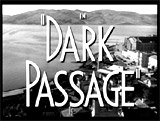



Dark Passage (1947), 106 minutes, D: Delmer Daves
Director Delmar Daves adapted David Goodis' 1946 novel of the same name for this film. The noir was similar in plot to The Fugitive (1993) and The Shawshank Redemption (1994). It was another drama teaming Bogart and Bacall (their third of four films together, following To Have and Have Not (1944) and The Big Sleep (1946)), although one of their lesser ones. Unique in that Bogart's complete face was not viewed for over an hour (obscured by shadows or bandages), when he finally removed facial bandages. The gimmicky, full-of-unlikely coincidences film was shot in an unorthodox way - from his subjective POV (looking through his eyes). In this thriller-noir, con Vincent Parry (Humphrey Bogart) - a lifer in prison for murdering his wife Gert, escaped from San Quentin by hiding in a barrel. He conveniently joined up with attractive and wealthy artist Irene Jansen (Lauren Bacall), sympathetic to his plight to prove his innocence, because her recently-executed father was also falsely accused for a similar crime. Her evil friend Madge Rapf's (Agnes Moorehead) testimony had helped to frame Parry in the first place. To deter attention and mask his identity, Parry underwent plastic surgery on his face from Walter Coley (Houseley Stevenson), and changed his name to Alan Linell. Then with faithful Irene's help, he attempted to clear his name and prove that he didn't kill his wife. He was doggedly pursued by small-time, blackmailing hood Baker (Clifton Young), who argued and gun-played with Parry at Fort Point and fell to his death from a cliff. To make matters worse, Parry was also framed for the death of his close friend George Fellsinger (Rory Mallinson). In the conclusion, it was revealed that Madge had killed both Parry's wife and George. When Parry confronted Madge to force her to sign a confession, she struggled with him, stumbled and fell from a window. In the unusual happy ending (for a film noir), Parry fled with Irene to Paita, Peru where they danced in an oceanside nightclub to the song Too Marvelous for Words.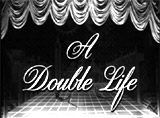



A Double Life (1947), 103 minutes, D: George Cukor
Cukor's noirish psycho-melodrama, with an excellent script of sharp dialogue by the husband-wife team of Ruth Gordon and Garson Kanin, also had an Oscar-winning score by Miklos Rosza. It told about famous Broadway matinee-idol actor Anthony John (Oscar-winning Ronald Colman in a career-topping role) whose stage roles were taking over his obsessed, off-stage personal life. The veteran actor knew that there would be disastrous consequences during his performance of different roles - for example, he had divorced his ex-wife Brita (Signe Hasso) two years earlier while acting in a Chekov play. He feared what would happen in real life if he took the role of Shakespeare's jealous Moor named Othello, with Brita as his leading lady Desdemona. It was a torturous role for him, as every night on stage, he was forced to strangle his wife due to jealousy. During these pressurized performances, his jealousies overtook him. When he feared that Brita was in love with somebody else, their publicist Bill Friend (Edmond O'Brien), he was compelled to act as Othello. He strangled his lover-mistress Pat Kroll (Shelley Winters in a star-making role), a pathetically-lonely, mid-20s slutty waitress he had met in an Italian restaurant. The curtain-falling conclusion of Othello blurred the boundary between art and life when the delirious actor stabbed himself to death on-stage.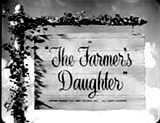


The Farmer's Daughter (1947), 96 minutes, D: H.C. Potter
Not to be confused with the 1940 film of the same name starring Martha Raye. It was based on the Finnish play Juurakon Hulda by Hella Wuolijoki that was purchased by David O. Selznick, potentially for Ingrid Bergman. It was later created as a TV series in 1963 starring Inger Stevens. In this delightful and smart romantic comedy (with a Cinderella theme), Loretta Young (in an Oscar-winning signature role) starred as Katrin Holstrom, the Swedish daughter of stalwart Minnesota farmer (Harry Shannon). In the big city of Washington DC where she was planning to attend nursing school, lecherous painter-acquaintance Adolph Petree (Rhys Williams) swindled her out of her savings. With nowhere to turn, she became the maid-servant or housekeeper (and lover) of US Congressman Glenn Morley (Joseph Cotten) and his powerful politico mother Agatha (Ethel Barrymore). Learning how the political game was played by her association with him and crusty butler Joseph Clancey (Charles Bickford), the feisty, independent-minded, and common-sensed Katrin decided to improve politics. She ran as a Reform candidate in an opposition party against the corrupt political machine (and its replacement candidate for a deceased officeholder) - it was very similar to the conclusion of many Frank Capra films. As a result, although there was a smear campaign to discredit her, she won the election and went to Congress with Glenn.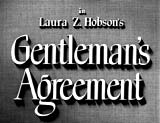

Gentleman's Agreement (1947), 118 minutes, D: Elia Kazan
The compelling and controversial film (at the time) was adapted by Moss Hart from Laura Z. Hobson's best-selling novel (originally serialized in Cosmopolitan), although now somewhat dated in its impact. It was the top grossing picture for 20th Century Fox in 1948, and one of the first Hollywood films to confront the problem of anti-Semitism, bigotry and religious prejudice. This morality tale was one of a number of films that explored serious social issues in the 1940s. The film's title referred to the "gentleman's agreement" practice of Gentiles (non-Jews) discriminating against Jews. Kazan's startling, Best Picture-winning sober drama was a powerful, sentimental and melodramatic story about a non-Jewish magazine reporter-journalist Philip Schuyler Green (Gregory Peck), a recently-widowed single father. He had writer's block about a new assignment - an expose-article on the subject of anti-Semitism for his liberal Smith Weekly magazine publisher John Minify (Albert Dekker) - until he decided to go undercover and pose as a Jew (with the name Phil Greenberg) to have a first-hand experience. Predictably, he encountered prejudice, scorn and hatred. His son Tommy (Dean Stockwell) was bullied in school (and called names such as "dirty Jew and stinking kike"), and his complacent, close-minded socialite girlfriend Kathy Lucy (Dorothy McGuire), a divorced schoolteacher and niece of Smith Weekly's editor, was snubbed by her Darien, Connecticut friends. Green experienced religious abuse and bias when rejected for a hotel room. The magazine's sharp-tongued fashion editor, a counterpoint to Green, was Anne Dettrey (Oscar-winning Celeste Holm), and his childhood Jewish friend was Dave Goldman (John Garfield). Deeply-rooted prejudice and underlying anti-Semitism were revealed in his friends, colleagues, and casual acquaintances.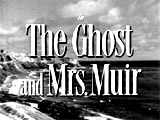




The Ghost and Mrs. Muir (1947), 104 minutes, D: Joseph L. Mankiewicz
Joseph Mankiewicz' charming, turn-of-the-century romantic fantasy, was based on the 1945 R.A. Dick (Josephine Leslie) novel with a script by Philip Dunne. It later became a TV series. It told about a young and independent, strong-willed but lonely widow Lucy Muir (Gene Tierney) with a young daughter Anna (Natalie Wood) in Victorian England. She discovered a salty, hot-tempered naval sea captain Daniel Gregg (Rex Harrison) as a ghostly presence in her English seaside Gull Cottage, in the town of Whitecliff-by-the-Sea. Windows and doors opened on their own, candles blew out and there was disembodied laughter. The source of the spookiness was undoubtedly Gull Cottage's former owner who was haunting the bedroom and thoughts of Lucy in his non-flesh-and-blood form. The film's tagline asked: "Is Lucy Muir's love really a ghost, or is it a man of flesh and blood she yearns for?" She refused to be scared by the ghostly denizen of the spiritual world, however, and struck up a strong bond with some romance. When she acquired debts, he helped her to be a "ghostwriter" - composing a successful, best-selling novel of autobiographical memoirs about his own life, titled Blood and Swash, that she transcribed from his dictations. In the meantime, she was charmed by smooth-talking cad Miles Fairley (George Sanders), an author of children's books. Gregg's jealousy was sparked, and she became uncertain of the captain's motivations when he warned her about the adulterous suitor. The ghostly sea captain decided to bid good-bye to Lucy while she slept. He told her that she must find her own way in life - and that she was only dreaming of a sea-captain haunting the house. In the transcendent, tearjerking final scene many years later, white-haired, elderly widow Lucy died in her British seaside cottage's armchair when Captain Gregg reappeared and greeted her with outstretched hands: "And now, you'll never be tired again, come Lucia, come my dear." Rejuvenated and young again, she walked off, hand-in-hand with him downstairs and through the front door into the afterlife with him.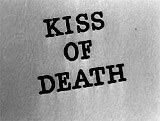



Kiss of Death (1947), 99 minutes, D: Henry Hathaway
Director Hathaway's definitive crime noir with a methodically-paced script was written by Ben Hecht and Charles Lederer. To convey authenticity, all of the film's scenes were shot in the state of NY - the actual locale of the story. In the initial sequence, an unidentified female voice-over began to narrate a flashback. To support his family, unemployed crook and ex-con Nick Bianco (Victor Mature) "went Christmas shopping" on Christmas Eve with two other thugs in the Chrysler Building's exclusive 24th-floor jewelry store. The heist was botched when their escape was delayed by a descending elevator, and Bianco (the only one in the group of four thugs) was shot in the leg and arrested. The Ass't District Attorney Louis D'Angelo (Brian Donlevy) met with Bianco and offered him leniency if he "squealed" on his three accomplices. Bianco - who had a wife named Maria and two infant daughters (Consetta or "Connie" and Rosario or "Rosie"), stubbornly refused to be a "stoolie." His shady shyster crime lawyer Earl "Early" Howser (Taylor Holmes) promised to take care of him, but he failed and Bianco was sentenced to 20 years at Sing Sing Prison (in Ossining, NY). Three years into Bianco's sentence, he learned that his depressed, heavy-drinking wife had committed suicide, and his two children were sent to an orphanage. He decided to reconnect with D'Angelo and offered to now rat on the other criminals, in order to receive early parole and to see his children. The main target that the DA wanted to nab was sociopathic, maniacal, cold-blooded killer Tommy Udo (Oscar-nominated Richard Widmark in his screen debut). Bianco squealed on his three accomplices, including the unseen driver Pete Rizzo. Then, to cover for Bianco's betrayal, it was implied that Rizzo was the one who had talked about a previous crime - the Thompson Fur heist. Howser got in touch with the homicidal Tommy Udo to get rid of Rizzo. In the film's most frightening sequence, Udo entered the apartment of elderly, crippled Mrs. Rizzo (Mildred Dunnock) (the mother of alleged informant Pete Rizzo), and to seek revenge, he terrorized her by ripping out a lamp's electrical cord and tying her to her wheelchair; as she protested, he then proceeded to roll her out of her apartment to the top of a long flight of stairs - and chuckled to himself as he shoved her forward to her death. In the meantime, Bianco became romantically involved with ex-housekeeper Nettie Cavallo (Coleen Gray), who had loved him from afar for many years. They were married and he regained custody of his two children, and then he attempted to settle down as a family man in Queens. However, D'Angelo called Bianco for another favor - to force him to testify against Udo in a trial for a different previous crime (that he had bragged about to Bianco), and to their surprise, Udo was acquitted. Bianco knew that the police couldn't adequately protect him or his family from Udo's revenge, so he sent his family away temporarily to the country for their safety, and then decided to proceed on his own, without accepting D'Angelo's offer of help ("I'm through trusting you, the police or anybody but me. There's only one way to get Udo, and that's my way"). In the film's exciting conclusion, Bianco confronted Udo and his gang members after midnight at Luigi's Restaurant in Harlem, in order to entrap Udo into using a gun. He alerted the nearby police precinct to his plan, and they promptly arrived on the scene (and shot and apprehended Udo), but in the aftermath, Bianco was severely injured with multiple gunshot wounds. However, he had survived the ordeal and was able to find peace with his wife and children once again.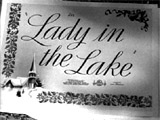



Lady in the Lake (1947), 105 minutes, D: Robert Montgomery
Robert Montgomery both directed (his directorial debut film) and starred in this Christmas-themed classic crime noir, adapted from Raymond Chandler's 1944 novel of the same name by Chandler himself. It featured a unique gimmick - an experimental and revolutionary subjective (or first-person) camera technique, meaning that the main protagonist was off-camera for most of the film, although sometimes viewed in mirrors. The mystery plot was very convoluted and twisting - difficult to follow at times. It basically involved a search by writer/detective Phillip Marlowe (Robert Montgomery) for a missing, promiscuous wife who had allegedly run off to Mexico with a handsome, gigolo boyfriend named Chris Lavery (Dick Simmons). The quest for the missing woman ("Chrystal Kingsby") was instigated by a gold-digging femme fatale Adrienne Fromsett (Audrey Totter) who had ulterior motives to marry Chrystal's rich husband - her own boss Derace Kingsby (Leon Ames). The detective's search discovered that the wife might be responsible for the murder of a mysterious "lady in the lake" found near a summer cabin near Little Fawn Lake owned by Kingsby. The victim was initially identified as 'Muriel Chess' - the wife of Kingsby's cabin caretaker Bill Chess, and he was charged with the crime. A key discovery was that Muriel had another name - Mildred Havelend. Soon after, Lavery's suspicious landlord 'Mrs. Falbrook' (Jayne Meadows) was seen just before Lavery's shower murder. It was up to Marlowe to fit the pieces together and discover who was behind the murders (involving switched identities, a deadly love triangle and a double-cross) - and to discover the deadly motives of 'Mrs. Falbrook' (with her many aliases). The key to the whole plot was the identity of 'landlady' Mrs. Fallbrook. She was actually the supposedly-drowned Muriel Chess/Mildred Havelend who had married Bill Chess, Kingsby's caretaker, and then assumed the married name of Muriel Chess, in order to hide her real identity as Mildred Havelend from a "tough cop" named Lieut. DeGarmot (Lloyd Nolan). It was more than likely that Chrystal was the corpse in the lake, not Muriel. In the film's conclusion, Marlowe figured out that Mildred/Muriel and Chrystal had jealously fought over handsome male Chris Lavery. This rivalry was clearly Mildred's motive to kill Chrystal and make it look like Muriel was the dead body in the lake, so she could run away with Lavery. After Chrystal's drowning/murder, Mildred fled and ran away to El Paso - and Lavery "was the only one who knew the real identity of the lady in the lake" - the reason that Mildred returned and also eliminated him and killed him in the shower. A sub-plot involved Lieut. DeGarmot who had partnered with Mildred to help her to hide and cover up the murder of a doctor's wife named Florence Almore. After his help and the case closed, Mildred fled from him. She "double-crossed" the love-struck DeGarmot by abandoning him and changing her name to Muriel Chess (after marrying Bill Chess, Kingsby's caretaker) with the intent to hide and get away from the "tough cop." In the final scene, DeGarmot caught up with Mildred and described his feelings of double-cross and betrayal by her. Marlowe attempted to dissuade DeGarmot: ("The Almore case won't come up. They'll convict her for Chrystal's murder or Lavery's. You'll be clear"), but DeGarmot's intention was to kill both Marlowe and the deceitful Mildred with her gun and stage it to look like she and Marlowe had shot each other, in order to frame them for the other murders. She begged for her life, but to no avail. DeGarmot shot her multiple times - point-blank - in view of Marlowe. The crooked cop DeGarmot was then gunned down by Captain Kane (Tom Tully) and another officer through a window, before he could kill Marlowe. At the end of the film after the case was solved, Adrienne and Marlowe left NYC together to begin a serious romance.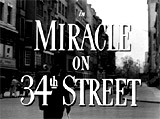




Miracle on 34th Street (1947), 96 minutes, D: George Seaton
This popular, perennial Thanksgiving and Christmas holiday favorite that was adapted from Valentine Davies' original story, was a dramatic comedy-fantasy about the commercialization of Santa Claus and Christmas itself. The sentimental and appealing Frank Capra-esque morality fantasy tale (similar to Meet John Doe (1941)) was about the struggle between faith and doubting cynicism, as well as between the holiday spirit of generosity and materialistic commercialism. When a hired Macy's Santa Claus participating in NYC's Thanksgiving Day parade (up 5th Ave.) was discovered to be intoxicated by a white-whiskered, kindly old man calling himself Kris Kringle (Best Supporting Actor-winning Edmund Gwenn), Kringle was offered an emergency replacement job by special-events parade director-organizer and divorced, workaholic single mother Doris Walker (Maureen O'Hara). The new, grandfatherly jolly fellow from the North Pole proved to be a smash hit following the parade and was appointed as the store's new Saint Nick. Some questions were raised when he endorsed and sent customers to other rival, competing department stores, such as Gimbels, when Macy's didn't have the desired merchandise. And when toy department boss Mr. Julian Shellhammer (Philip Tonge) urged Kringle to memorize and push a list of overstocked toys on undecided children, the 'Santa' expressed his disgust at X-mas commercialization. The store's incompetent psychologist Mr. Sawyer (Porter Hall) questioned Kringle's 'insane' fantasy that he actually was Santa. Doris' doubting, equally cynical, wide-eyed, and delightfully-precocious young second grade daughter Susan Walker (Natalie Wood) also thought Kringle was only a fairy-tale - she did not believe in childhood dreams. When Doris urged Kringle to tell Susan that Santa didn't exist, Kringle's insisted that he really was Saint Nick. Susan didn't believe that the actual, warm-hearted, white-haired Kris Kringle was real, and pulled his beard to test him. Kris Kringle also entered into a concerned conversation with Doris about the loss of the real meaning of Christmas: ("For the past 50 years or so, I've been getting more and more worried about Christmas. Seems we're all so busy trying to beat the other fellow in making things go faster, and look shinier, and cost less that Christmas and I are sort of getting lost in the shuffle"). The most touching moment in the film occurred when children were in line to see and speak to Santa. Susan watched from the side and was impressed as Kringle kind-heartedly and reassuringly sang to a frightened, non-English-speaking refugee and Dutch immigrant girl/orphan (Ida McGuire) in her native language. He performed a duet with her of a traditional Dutch carole. Eventually, Doris made the shocking discovery that Santa's address, revealed in his work application, was the Brooks' Memorial Home for the Aged in Great Neck, Long Island, NY, where he was a nursing home resident. The resident physician Dr. Pierce (James Seay) claimed that 'Santa' was delusional but not dangerous. However, psychiatrists from Bellevue Hospital threatened to have him committed and put away in a mental institution, although Kringle's twinkly-eyed earnestness and wholesomeness eventually removed the doubts of even the skeptical Doris and Susan. Before Kringle was committed to Bellevue, Doris' handsome bachelor lawyer-friend Fred Gailey (John Payne) - her love interest and next-door neighbor, had convinced presiding NY State Supreme Court Judge Henry Harper (Gene Lockhart) to hold a hearing to determine Kringle's mental health (sanity or lunacy). A memorable court hearing battle that extended through Christmas Eve, pitted two lawyers against each other; Fred Gailey took the defense to prove that Kris was truly Santa while the state's DA Thomas Mara (Jerome Cowan) was out to prove that Kringle was insane. During the stirring finale, Susan wrote a letter to Kris Kringle to cheer him up while in court for his insanity hearing (with her mother's added postscript: "I believe in you, too"). Gailey needed to prove his case that it was wrong to vilify Santa Claus, and at the same time acceptable to have faith in the red-suited character and believe in the power of imagination (and the Christmas spirit). On his side was the idea that it would cause a backlash to rule against Kris Kringle, and against the possible existence of Santa Claus. In a showstopping strategic move during the courtroom scene, Gaily asked questions of the District Attorney's young son Tommy, Jr. (Bobby Hyatt) on the witness stand: "Do you believe in Santa Claus?" and "Why are you so sure there's a Santa Claus?" - and the boy answered affirmatively that his dad had told him so. It was a winning maneuver proving that Santa Claus actually existed. In a climactic display of US mail evidence, Gailey also cleverly produced 21 bags and stacks of thousands of post office letters addressed to Santa Claus from the 'dead letter' section of the Post Office. His argument was that the US government agency's recognition of these letters was "positive proof" of Santa Claus' existence. The judge agreed and dismissed the case, and Kringle was released. The concluding scene featured Susan in a car with Gailey and Doris (now in love) on Christmas Day, as they drove up to the house of her dreams - a house (with a "For Sale" sign). It was a special present that she had hoped would come from Santa. She repeatedly tried to keep persuading herself to have faith (and believe in Santa): "I believe" - and then expressed her overwhelming joy when Kris Kringle's gift came true. Now a firm believer in Kris Kringle (or Santa), she told Fred and Doris after wildly running through the house: "But this is my house, Mommy, the one I asked Mr. Kringle for. It is! It is! I know it is!" Gailey kissed Doris and proposed to her in their future home, while Susan helped to persuade them to think about purchasing the house - but after seeing Kris' cane standing beside the fireplace, Fred expressed his doubts about brilliantly winning the case: ("Maybe I didn't do such a wonderful thing after all").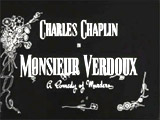



Monsieur Verdoux (1947), 124 minutes, D: Charles Chaplin
Chaplin's ahead-of-its-time Bluebeard crime drama and black comedy, based upon the notorious French killer named Henri Landru, was subtitled: "A Comedy of Murders." The subversive and satirical film, taken from an idea by Orson Welles, was considered controversial and unsettling in its post-war time period, and became a box-office failure - although has now attained the status of a cult-classic. It was Chaplin's first film in seven years (after The Great Dictator (1940)), and very different from his popular "Little Tramp" character. The film told about a straight-laced Parisian bank clerk-teller named Henri Verdoux (Charlie Chaplin), who had an invalid, wheelchair-bound crippled wife Mona (Mady Correll) and young son Peter (Allison Roddan) to support. Around the time of the Great Depression after he lost his job of 35 years, the suave, dapper, cynical, middle-aged and unemployed Verdoux became a notorious serial killer murderer and bigamist whose preferred modus operandi was to marry middle-aged wealthy women, murder them, and appropriate their money. He used several aliases (e.g., Varnay, Bonheur, and Floray, etc.) in order to marry almost a dozen women simultaneously. The comedic highlight of the film was that one of the would-be victims, widowed Annabella Bonheur (scene-stealing, big-mouthed comedienne Martha Raye) kept winning lotteries, and also proved challenging to eliminate for Verdoux. His murder attempts continually failed due to her fortunate good luck. When the stock market crashed and the banks failed, Verdoux found that he was broke. He turned himself into the police after being suspected by a victim's relative. He was put on trial - and before being convicted, he delivered a courtroom speech about how society was hypocritical ("As a mass murderer, I'm an amateur by comparison"). He argued that world wars, dictators, and mass genocidal killings were sanctioned by society and other countries, but his own crime of killing only a few out of necessity (in order to survive) brought about a sentence of death by guillotine.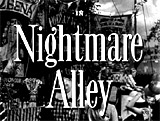


Nightmare Alley (1947), 110 minutes, D: Edmund Goulding
Director Edmund Goulding's dark, bleak, fatalistic and very disturbing crime-noir was basically the story of the rise and precipitous fall of a con-man - an overly-ambitious, cynical and fake mentalist/spirtualist or clairvoyant. The repulsive tale of decadence, doom and deception was based upon William Lindsay Gresham’s 1946 novel of the same name, with a screenplay by Jules Furthman. [Note: Director Guillermo Del Toro's remake Nightmare Alley (2021) starred Bradley Cooper and Cate Blanchett in the two lead roles.] Handsome roustabout drifter Stanton "Stan" Carlisle (Tyrone Power) had just joined a carnival as one of its hustlers. He was fascinated by a performance of The Geek (George Beranger) - one of the carnival's biggest draws, presented by the main carnival barker/owner Hoatley (James Flavin): Stan was tutored in the tricks of the trade by Miracle Woman Zeena Krumbein (Joan Blondell), a fortune-teller whose assistant-husband Pete Krumbein (Ian Keith) was a spent, over-the-hill drunkard, who helped her to deceive audiences. Stan fell in love with young, pretty carnival worker Molly (Coleen Gray) - the 'Electric Girl' and current girlfriend of possessive Bruno the Strongman (Mike Mazurki). Fate intervened when Stan accidentally handed an anxious, shaky Pete a bottle of Zeena's wood alcohol from her prop trunk, and he died of poisoning. It was time for Stan to leave the carnival troupe, and after a quick shotgun marriage to Molly, the two fled and went on the road performing together with their own mentalist show. He headlined as "The Great Stanton" at an exclusive nightclub (The Spode Room) in the Chicago-area's Hotel Sherman, where he performed with Molly, and they became a solid hit. One of their show's attendees was consulting psychologist Lilith Ritter (Helen Walker) who was extremely skeptical of Stanton's question-answering charade. To outwit him, she tested him but he was able to answer correctly. Later, she invited him to her Lakeshore Building business office, where he realized she was secretly recording the interview-sessions of all her wealthy, high-class patients. They entered into a pecuniary deceitful scheme and partnership to illegally use the information from her recordings to make money off her elite clientele by channeling their dead relatives. She also offered therapy sessions to Stan, that she secretly recorded. One rich client named Ezra Grindle (Taylor Holmes) hired Stan to provide "spiritual communion" with his lost sweetheart Dorrie from 35 years earlier. Lilith conspired and teamed up with Stan by providing him with recording information about Grindle. The gullible and reluctant Molly was persuaded to be in on Stan's scheming "subterfuge" by masquerading as the 'materialization' of the ghostly spirit of Grindle's dead love. During the channeling escapade, the anguished and distraught Grindle saw 'Dorrie' in the distance and begged for her forgiveness. Molly revealed that it was a fake illusion, and Grindle suddenly realized he had been swindled by the charade. Stan and Molly had no choice but to leave town. Stan also hurriedly met with Lilith and described their failed plan. She gave him an envelope with $150,000 in cash, and encouraged him to flee and not contact her. Later, he realized he had been swindled, and was given only $150 dollars. He returned to Lilith's office and confronted her, but she treated him as one of her disturbed patients. She threatened that if he accused her of complicity, she would play the recording of his confession regarding Pete's death. Realizing that he had been fully tricked, Stan fled to the train station, where he ordered Molly to somehow return to the carnival in Galesburg, IL before the train pulled away without him. Stan's fortunes and career were destroyed - he became a down-and-out vagrant hobo. He sought work in the local carnival from the new owner McGraw (Roy Roberts), but was refused work because he was an obvious "boozer" - but then after begging, he was offered the exploitative job of Geek. Unbeknownst to him, Molly was working in the carnival and devotedly promised to care for him: ("Everything's gonna be all right now. I'll look after you") as Zeena had done for Pete.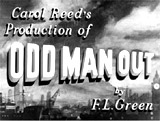







Odd Man Out (1947, UK), 116 minutes, D: Carol Reed
Carol Reed's searing, exciting and suspenseful crime drama was a rich character study about a rebel leader - a doomed man-on-the-run. It was a great example of a post-war British film thriller (adapted from F.L. Green's 1945 novel) with gritty black and white cinematography. It began with the following crawl: "This story is told against a background of political unrest in a city of Northern Ireland. It is not concerned with the struggle between the law and an illegal organisation, but only with the conflict in the hearts of the people when they become unexpectedly involved." In the film's plot, Irish rebel, IRA-like nationalist gunman Johnny McQueen (James Mason in one of his best performances) had been evading the police after escaping from prison six months earlier. He was hiding out the house of his loving girlfriend Kathleen Sullivan (Kathleen Ryan in her debut film) and her Grannie (Kitty Kirwan). He had just participated in a daring, unsuccessful payroll robbery-holdup attempt at a mill-factory, presumably in Belfast (Northern Ireland), to fund the underground operations of "The Organization." He was lethally wounded in the left shoulder and dying after the failed robbery that included his own killing of the armed cashier. At the time of the robbery, Johnny was experiencing vision problems, vertigo and dizzyness - all expressionistically visualized. His problems multiplied when he was accidentally left behind by the getaway driver Pat (Cyril Cusack). He continued to experience hallucinations, irrationality and mental torment. Johnny lost control of his destiny (and free will) as he desperately struggled to avoid capture in the streets of Belfast, and sought shelter in the city's air-raid shelter, ghettos, deserted buildings, pubs, and back alleys (and even in a junkyard bathtub), when he couldn't get back to Kathleen's place. As the British dragnet around him closed in tighter, for eight tense hours, he was pursued in a manhunt by the police and others - all with their own motives of either helping him, dismissing him out of fear, or exploiting him by turning him in to the authorities to claim the £50,000 reward. They included his girlfriend Kathleen, IRA buddy-partners Dennis (Robert Beatty), Pat and Nolan (Dan O'Herlihy) who wanted to rescue him (Pat and Nolan were gunned down after informed upon by Theresa O'Brien (Maureen Delaney)), hansom cabdriver "Gin" Jimmy (Joseph Tomelty), Catholic priest and Johnny's childhood teacher Father Tom (W. G. Fay) ready to deliver last rites, bird-dealer and poor street con-man/hustler Shell (F. J. McCormick), barman Fencie (William Hartnell), a crazed and eccentric homosexual painter Lukey (Robert Newton) who wished to paint Johnny's portrait, failed ex-medical intern student Tober (Elwyn Brook-Jones) (Shell's housemate), and a sympathetic law-enforcing police Inspector (Denis O'Dea). With visual religious symbolism of crucifixion, McQueen became a Christ-like figure as a condemned man slowly approaching death. McQueen was compelled to pose for the painter for endless hours as a model for a series of Christ paintings - the artist was obsessed with painting the eyes of the dying man. In the film's violent conclusion in snowy Belfast, Kathleen met up with Johnny at the waterfront as the two were attempting to escape on a ship together that she had arranged, while the police closed in on them. As Johnny tired and struggled, he fell back against an iron gate (with arms extended in a crucifix pose), as their ship was leaving without them in the distance. Kathleen had protectively decided to transcendentally and romantically sacrifice herself with Johnny rather than let him endure capture and execution. She deliberately and wildly fired two shots. It was ambiguous whether she fired at the police to force them to retaliate, or killed Johnny to prevent him from being captured by the police. Her two shots drew a barrage of gunfire from the police, leaving both of them dead - they expired in each other's arms.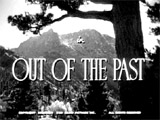


Out of the Past (1947) (aka Build My Gallows High), 97 minutes, D: Jacques Tourneur
Director Jacques Tourneur's beguiling, complex film noir about double-dealing and intrigue was filmed during the post WWII period, with a script by Daniel Mainwaring (aka Geoffrey Homes), and uncredited pulp novelist James M. Cain. The picture was aka Build My Gallows High, and based on Geoffrey Homes' novel, and remade as Taylor Hackford's Against All Odds (1984), starring Jeff Bridges and Rachel Ward. This enthralling, convoluted classic film noir was laced with doom-laden flashbacks from the shady past. It told about a laconic, former private detective who was caught twice in a deathly web. The film began as a flashback by the film's main protagonist Jeff Markham/Bailey (Robert Mitchum) to his fiancee-girlfriend Ann (Virginia Huston) - as he described his past -- driving with her on his way to meet with two past associates. The story actually began with Jeff's escape from his past - he had moved to the small California town of Bridgeport in the mountainous country to find solitude (and work as the owner of a gas station), and had changed his last name to Bailey. He found himself tracked down by ex-business associate Joe Stefanos (Paul Valentine), and was reluctantly forced to meet again with underworld gangster Whit Sterling (Kirk Douglas) at his Lake Tahoe retreat. During the drive to Tahoe, Jeff told Ann about how three years earlier, he had been a private detective in New York with partner Jack Fisher (Steve Brodie). They had been hired by gambler Whit to find his duplicitous girl friend, Kathie Moffat (Jane Greer), who had shot Whit and allegedly stolen $40,000 dollars before fleeing. Jeff journeyed to Acapulco where he first came under the lethal, deceptive erotic spell of the irresistible femme fatale in an ill-fated affair. He was forced to go into hiding when Whit and Stephanos suddenly appeared at Jeff's Mexico hotel, and the couple fled to San Francisco to live together for a short while. Jeff was tracked with Kathie to a remote Sierra Nevada cabin by his ex-partner Fisher (who was now working for Whit), where Kathie shot Fisher dead and left Jeff to be blamed for the killing - concluding their affair. Now in the present time, after arriving at Sterling's place, the worn-out detective Jeff learned that the double-crossing Kathie had returned to Whit and told him about her affair with him. The laconic Jeff was again being hired by Whit for one more last, unsavory assignment that would bring him out of retirement. He was blackmailed into helping the vengeful Whit, in order to redeem himself, and make up for his mistake in the past. Jeff was to retrieve Whit's tax papers from a crooked SF lawyer named Leonard Eels (Ken Niles), who threatened to report him to the IRS. During Jeff's involvement and return to his past, he became involved in another complex web of intrigue, passion, betrayal, double and triple-crosses, and death. His paths again crossed with the wicked Kathie he had once loved and lost, and he was again doomed and seduced by the same charming woman. Kathie and Whit's ally Meta Carson (Rhonda Fleming), Eels pretty secretary, double-crossed Jeff by conspiring to frame him as the murderer of both Fisher and Eels (who was killed by Stephanos), with Kathie's signed affidavit attesting to the fact that he had killed Fisher. Jeff escaped from SF when he became the object of a manhunt, and returned briefly to Bridgeport, where Stephanos had been secretly assigned by Kathie to find Jeff and kill him - Stephanos ended up dead instead. Jeff was finally able to confront Whit at his Tahoe lodge about Kathie's double-cross and Stephanos' death. There, Kathie shot Whit dead and persuaded Jeff to run away with her back to Mexico (since he could now be charged with three murders!). As they drove away, Jeff had alerted authorities who set up a road-block. Knowing that he had betrayed her, she angrily shot him dead and also perished in the standoff with police.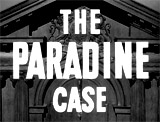




The Paradine Case (1947), 125 minutes, D: Alfred Hitchcock
Based upon the 1933 novel by Robert Smythe Hichens, and noted as Alfred Hitchcock's final film for producer David Selznick. In the year 1946 in England, beautiful and exotic young wife Maddalena Anna Paradine (Italian actress Alida Valli) was accused of poisoning her blind, elderly and wealthy husband Colonel Richard Paradine, a retired WWI hero. However, it was unclear whether it was suicide or murder, or whether the hostile Canadian valet Andre LaTour (Louis Jourdan) was involved. Was Mrs. Paradine being falsely accused? Successful married London barrister-counselor Anthony "Tony" Keane (Gregory Peck) was hired by the family's solicitor Sir Simon Flaquer (Charles Coburn) to take the case to defend the accused murderess (and possible femme fatale). Not long after, Keane fell in love with her, neglecting his 11 year-old marriage to his kind and loyal wife Gay (Ann Todd). Gay realized her straying husband's passionate relationship to his attractive yet enigmatic client, but supported him so that he wouldn't be lost to her forever if she was convicted. The trial was presided over by sarcastic, bullying Judge Lord Thomas Horfield (Charles Laughton). Blinded and infatuated by love, defense lawyer Tony Keane tried to put the blame on a scapegoat - the Colonel's valet LaTour, although he vehemently denied it. However, under cross-examination in a dramatic scene, LaTour revealed that he was committing adultery with Mrs. Paradine, and some of his conflicting testimoney raised doubts about whether he assisted the Colonel in committing suicide. After testifying to his own guilt about the affair with Anna (but not about poisoning the Colonel), LaTour killed himself. Then, Mrs. Paradine admitted that she had initiated the affair, although the valet remained loyal to the Colonel. When the Colonel learned of the sexual indiscretions of LaTour, however, the valet was discharged. Then, Mrs. Paradine revealed that she had poisoned her husband with a poisoned wine glass. In the final scene, she then denounced the disreputable Keane for falling in love with her, and for destroying her real love, LaTour due to his strategy to condemn and blame LaTour during the trial. Keane confessed his major limitations and his devastation over the revelations, and withdrew from the court. He was soon reconciled with his conciliatory and supportive wife Gay. For her crime, Mrs. Paradine was sentenced to execution (by hanging): ("The Paradine woman will be hanged after three clear Sundays").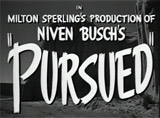


Pursued (1947), 101 minutes, D: Raoul Walsh
Raoul Walsh's noirish, melodramatic psychological western was told mostly in flashback, and noted for cinematographer James Wong Howe's film-noir chiaroscuro (black and white) photography and Max Steiner's musical score. The western setting was the remote New Mexico Territory at the turn of the century. Anti-hero, orphaned Jeb Rand (Robert Mitchum in an early role (his first lead role)) was "pursued" - literally and figuratively - by a haunted past (highlighted by nightmares of boots with jangling spurs and flashes of light, seen in flashbacks to the 1880s). He had witnessed the murder of his entire family as a young boy by a mysterious stranger, and suffered from repressed memories. [Note: There appeared to be a long-running feud between two families - the Rand family, and the Callum family.] Adopted and raised as a young boy by widowed "Ma" Callum (Judith Anderson), Jeb grew up with two step-siblings - "Ma" Callum's biological daughter Thorley (Thor) Callum (Teresa Wright), and her son: the competitive, antagonistic Adam Callum (John Rodney). The main "pursuit" in the film was by villainous, one-armed county prosecutor Grant Callum (Dean Jagger), Ma Callum's vengeful brother-in-law, who despised the Rand family and sole survivor Jeb. One day when Jeb (Ernest Severn) was about eleven years old, his horse was shot out from under him by an unseen stranger (Grant) - an attempt to kill him. Grant also continually baited others to bring Jeb down. But why? There were two coin tosses that decided Jeb's fate - both of which were lost by Jeb. He was forced to volunteer to fight in the Spanish-American War, and he also was compelled to give up the Callum ranch to his step-brother Adam. Soon after, Jeb was forced to defend himself against Adam during an ambush, and he killed him in self-defense (determined by a jury), although Ma and Thor thought he was guilty of murder. He had fallen in love with Thor despite the fact that they were almost siblings, and that Adam had objected to their wedding. Grant also prodded local boy Prentice McComber (Harry Carey, Jr.), one of Thor's suitors, to challenge Jeb to a gunfight in a dark stable - when Jeb shot and killed the boy. Thor and Jeb married on the hidden pretext that she had decided to kill him on their wedding night. Instead, she couldn't carry through on her promise and vowed her love instead. The climactic revelation was that when Jeb was younger, Grant was responsible for killing all the members of the Rand family, including Jeb's father, brother, and sister. The Rand ranch where the slaughter had occurred had since been abandoned. The true nature of the precipitating bitter feud with the Rand family was revealed. Grant Callum had revenge obsessions due to: (1) "Ma" Callum was having an incestuous affair with Jeb's father; when Ma Callum's husband (Grant's brother) discovered the infidelity, he attempted to murder Mr. Rand (Jeb's father) but was killed himself. (2) In revenge, Grant slaughtered Jeb's entire family - Grant was the mysterious stranger of Jeb's youth. Finally, there was a climactic violent shootout at Jeb's and Thor's house against the Callums and Ma - similar to the one that killed Jeb's entire family. Outnumbered, Jeb was forced to surrender and was about to be hanged. However, in the therapeutic ending, he was saved when Ma shot Grant. She atoned for her actions in the past, told Jeb about the true nature of the forces opposing him, assured him that his childhood trauma was over, and saved the young married couple.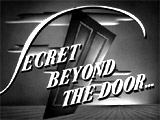



Secret Beyond the Door... (1947), 99 minutes, D: Fritz Lang
Director Fritz Lang's psychological mystery and Freudian drama-thriller was told in flashback (punctuated with self-conscious, confused voice-over narration), and featured the tagline: "Some Men Destroy What They Love Most!" It has sometimes been noted with the year 1948. It was one of Fritz Lang's lesser and least-successful works, derivative and similar to Alfred Hitchcock's Rebecca (1940), Suspicion (1941) and Spellbound (1945), and George Cukor's Gaslight (1944). Its great moody and shadowy black and white cinematography by Stanley Cortez was supplemented with a frenzied music score by Miklós Rózsa. The film opened with an engrossing dream sequence, and then an extended flashback occurring on the protagonist's wedding day. In New York, after the heart-ailment death of her beloved older brother Rick Barrett (Paul Cavanagh), socialite sister and fashionable heiress Celia Lamphere (Joan Bennett in her fourth and final film with director Lang) had a brief love affair with Rick's friend - family lawyer and dull financial administrator Bob Dwight (James Seay), and they planned to marry each other. Before marrying, during a vacation to Mexico with her best friend Edith Potter (Natalie Schafer), Celia met handsome, enigmatic and refined British architect Mark Lamphere (Michael Redgrave in his first US film), when they both witnessed a stimulating knife-fight in the marketplace between two locals vying for a beautiful senorita. She impulsively and recklessly agreed to marry him, although was apprehensive because she knew little about the emotionally-complex man. Soon after he skipped out on their wedding night, she learned that he was the mysterious owner of an architecture-themed journal-magazine, and the owner of a heavily-mortgaged suburban mansion in Levender Falls outside of NYC. Celia moved into his cavernous mansion, dubbed Blaze Creek, where she strangely discovered that Rick's despotic yet friendly spinster sister Caroline "Carey" Lamphere (Anne Revere) administrated the manor. His creepy housekeeper-secretary Miss Robey (Barbara O'Neil), who had a scarf covering burn scars (fake) on the side of her disfigured face, also lived there. Most curious was that Rick had been previously married to now-deceased Eleanor, and they had a weird, rebellious teenaged son named David (Mark Dennis) who had bitterly accused Mark of her suspicious murder. Mark explained his theory that a physical setting can influence and define psychological reactions. One of Mark's strangest behaviors, as an admirer of famous historical murders, was that he was an eccentric collector and reproducer of "felicitous rooms," designed as a macabre "museum" to showcase and bizarrely recreate a half-dozen notorious murder crime scenes. When the intrigued Celia investigated the secret and locked room # 7 - thinking it was the scene of Eleanor's death, she was unsettled to learn that it might be prepared for her - it was an exact duplicate of her own boudoir. Bluebeard Mark might want to kill her for her inheritance. In the final revelatory scene when they were alone together, mentally-unstable Mark threatened to kill Celia. She forced him to recollect repressed and dark traumatic childhood events to ease his mind, and convince him he was not a murderer. [The source of his rage: his sister had locked him in his bedroom when he had hoped to bid his mother goodbye.] They discovered that disturbed pyromaniac Miss Robey, fired from her job, had jealously and vengefully set fire to the house. Mark redeemed himself by saving Celia's life, as the film ended happily.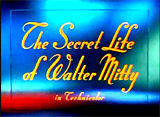


The Secret Life of Walter Mitty (1947), 110 minutes, D. Norman McLeod
This delightful Norman McLeod comedy classic was remade by Ben Stiller in 2013. It was loosely adapted from James Thurber's 1939 short story tale about a daydreaming escapist Everyman, clumsy Walter Mitty (Danny Kaye) - although extended with a spy-espionage caper plot. Employed as an assistant editor and proof-reader for a lurid pulp fiction publisher, Pierce Publications, owned by idea-stealing boss Bruce Pierce (Thurston Hall) in New York, Walter wildly fantasized about how he was a hero in adventurous episodes, to escape his mundane world. He lived with his overbearing, nagging and overprotective mother Eunice (Fay Bainter), and was disrespected by his self-centered, irritating fiancee Gertrude Griswold (Ann Rutherford) and her loud-mouthed mother (Florence Bates), and by best friend Tubby Wadsworth (Gordon Jones) - a romantic rival for Gertrude's love and the villain in Walter's fantasies. During one of his fantasies while he was commuting on a train to work, he met mysterious and gorgeous blonde Rosalind van Hoorn (Virginia Mayo). The glamorous femme fatale, the girl of his dreams, pretended that Mitty was her sweetheart, gave him a kiss, and handed him a black book to evade a dangerous international group of jewel thieves, led by The Boot, that were pursuing her. The book allegedly contained the location of various stolen Dutch art treasures by the Nazis, including crown jewels hidden since WWII. Rosalind was allied with her uncle Peter van Hoorn (Konstantin Shayne), the former curator of the Royal Netherlands Museum, to acquire the Dutch jewels by accessing the black book. Mitty was diagnosed by maniacal psychiarist Dr. Hollingshead (Boris Karloff), actually one of The Boot's henchmen, as suffering from crazed, non-stop daydreaming - including the entire plot about the black book. During the caper escapades, Mitty's imaginative and grandiose dreams included him as a famous brain surgeon admired by a pretty love-sick nurse, an WWII British RAF flying ace engaged in aerial dogfights while wooing a French barmaid, a Mississippi riverboat gambler, a heroic gunslinger in a Western shoot-out, a sea captain with daring seafaring adventures during a storm, and as gay woman's fashion hat designer Anatole of Paris. In the end, Mitty convinced his family and the authorities that he wasn't daydreaming about the spies, the book or Rosalind, and thereby became a brave heroic figure in reality - by thwarting The Boot - who was revealed to be Peter van Hoorn.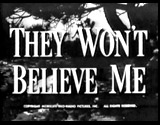



They Won't Believe Me (1947), 95/80 minutes, D: Irving Pichel
In this film noirish melodrama about adultery, philandering playboy Lawrence Ballentine (Robert Young) was on trial for the brutal murder of Verna Carlson (Susan Hayward). Before flashbacks to tell the defendant's unbelievable life-story (an 'unreliable witness' account), Ballentine's attorney Cahill (Frank Ferguson) claimed that his stockbroker client was innocent. Almost the entire film consisted of Ballentine's uninterrupted flashbacked story. Although married for five years to rich and loving wife Greta (Rita Johnson), he planned to take a train to run off to Montreal with tempting mistress Janice Bell (Jane Greer), a NYC magazine writer and one of Greta's friends. Greta tried to keep their marriage going by buying her husband's loyalty. She rented a Beverly Hills, California house, and purchased an interest in a stock brokerage firm. After about six months there, he again left Greta for sexy, femme fatale LA secretary Verna Carlson, working in his own firm. Greta thought she could still hold onto her husband by selling his interest in the partnership, and moving away with him to an isolated mountain ranch. Unhappy with the arrangement, Lawrence promised Verna that he would go to Reno to get a quickie divorce from his wife, and then they could begin their new life together. As they were driving to Reno, a truck collided with their car. Verna was horribly killed and burned in the wreckage, while Ballentine survived with a serious concussion. Ballentine realized that he could easily claim that it was Greta who died, so he concocted a complicated scheme to inherit his wife's fortune. He would carry out the deception by agreeing that Greta (not Verna) had died in the accident, then murder Greta, hide her body, and acquire her money. When he arrived at Greta's remote ranch, he found her already dead, presumably distraught over the divorce-breakup, and at the bottom of a cliff where she had fallen accidentally after an equestrian accident - or committed suicide. (However, there was one other real possibility: Had he pushed her, and then subconsciously felt guilty for murdering her?) To avoid suspicion, Ballentine left Greta's body to decompose in the river, and carried through with the rest of his scheme. Unfortunately for him, the police located Greta's remains, but thought it was Verna's body. Ballentine was charged with murder, after the police wrongly theorized that Larry killed Verna because she was blackmailing him over their affair. The story - told by Ballentine as the sole defense witness - returned to the courtroom where the jurors filed in with their verdict. Fearing the worst (was he actually guilty of a crime?), Ballentine attempted a desperate suicidal escape through an open courtroom window - when he was shot and killed. In the surprise ending, the jury's foreman read the verdict - not guilty!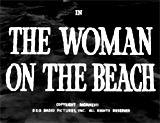

The Woman on the Beach (1947, Fr.) (aka La Femme Sur La Plage, or Desirable Woman), 71 minutes D: Jean Renoir
Renoir's moody, nightmarish erotic melodrama was a psychological character study about a tormented love triangle. It was the director's final American film during wartime exile. The film was severely edited by RKO, leaving it as only a fragment of what it could have been. Shell-shocked Coast Guard veteran Lieutenant Scott Burnett (Robert Ryan) was stationed near a desolate California coastline during recuperation from post-traumatic stress. Although engaged to wholesome local girl Eve Geddes (Nan Leslie), he became distracted and smitten in an illicit affair with slutty and passionate femme fatale Peggy Butler (Joan Bennett). Peggy was married to renowned blind painter Tod (Charles Bickford) and lived in an isolated clifftop house with him. Peggy was obsessively guilt-ridden within her unhappy, imprisoning, embittered and dysfunctional love-hate marriage to the excessively-jealous, wife-beating man, believing she had to stay with him because she had caused her husband's blindness (by cutting his optic nerve) during a drunken brawl. Lieutenant Scott Burnett took it upon himself to prove that the blindness was faked ("If I could prove to you that Tod wasn't really blind, would you leave him?") and in one extraordinary scene led the painter along a cliffside to disprove his disability. In the ambiguous ending, when Peggy proved her love to Scott (although her past as a nymphomaniacal seductress was revealed - "Go ahead and say it, I'm no good"), her husband Tod freed her by burning down their house ("I am free"), consuming all of his paintings. The reconciled couple departed to go to New York to start a new life, leaving Scott free to return to Eve.